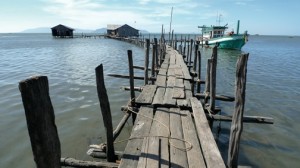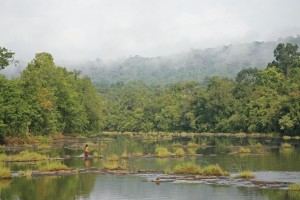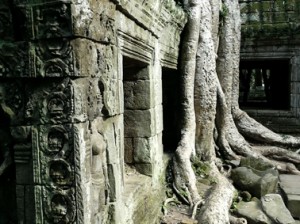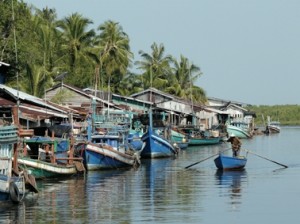From Transformers to Louis Vuitton: Filming on location in Cambodia
It’s frequently said that not much doubles for South East Asia, apart from the Asian South East. One very cheap and cheerful emerging option for all your Vietnamese, Philippine, Thai, Lao, Indonesian and Malaysian needs is Cambodia, as Transformers and Two Brothers have established.
Such was the power of Roland Joffe’s triple Oscar-winning The Killing Fields back in 1984, that for many people it is still the first thing that springs to mind when considering Cambodia. But the Cambodian Film Commission (CFC) is home to a knowledgeable gentleman named Cedric Eloy, who paints a surprisingly modern picture of an ancient country that is a cornerstone of international production:
“About ten years ago shooting in Cambodia could be a real challenge as nothing was organised and there was no real service industry. Then a few projects, including Jean-Jacques Annaud’s Two Brothers, set us new standards. Since then a film-friendly development policy made its way in and thanks to a few officials and film professionals the infrastructure of Cambodia has improved at every level.”
Cedric explains that 2010 saw Cambodia shift up a couple of gears. International feature film production increased 400%, including Chantal Akerman’s arthouse movie La Folie Almayer and the juggernaut that was Transformers: Dark of the Moon, which reportedly enjoyed unfettered access to the famed Angkor temples and a dizzying degree of local helpfulness in the capital Phnom Penh. In addition, Louis Vuitton had Angelina Jolie return to be photographed by Annie Leibowitz. Also, a series of HSBC commercials has just wrapped. Cedric is vastly experienced at shooting all over the country and reels off a list of exactly why they are so busy with international productions:
“We provide productions with experienced people for all departments and CFC does continuous training with international film professionals. Now Cambodian crews have better language skills than in other South East Asian countries and there are now excellent set construction teams that allow producers to build large structures for a third of what it would cost anywhere else. We also have blossoming props duplication and costume copying services that set designers appreciate, as our textile industry is huge.
Now Cambodian crews have better language skills than in other South East Asian countries and there are now excellent set construction teams that allow producers to build large structures for a third of what it would cost anywhere else.
Cedric Eloy, Cambodian Film Commission
“We have new lighting and grip equipment and other kit if it’s easily sourced in Bangkok, which is 40 minutes away by air. Also, the large expat community in Cambodia due to the presence of more than 3,000 Non-Government Organisations and foreign businesses makes it easy to find Caucasian extras. The road and hotel infrastructures, as well as widespread internet and mobile networks (3.5G) have improved the country's capacity to host larger productions. We also have specialist professional helicopter companies, speedboat rental and motor homes for actors, all of which have developed to meet the needs of this expanding industry.”
Cedric is also keen to set out the fiscal stall as well, showing lots of evidence that Cambodia will not break the budget:
“Cambodia has a very basic tax system so there are no social charges for employment of labour and services are taxed very little in general. It makes it a country where things are four times cheaper than in Europe, which means that we can say 30% to 70% off your normal production budget, but it does not fit to promote it as an incentive. Film-related imports are considered temporary imports and so are not taxed when coming in or going out. Also there are no ATA carnet fees. Foreign salaries and actors’ salaries are not taxed. Incentives are an asset in countries where life is expensive but a production budget in Cambodia is lower.”
Nick Ray, of Hanuman Films, one of the leading film services companies in Cambodia, is just as buoyant as Cedric:
“TV stars like Gordon Ramsay and Charley Boorman rated our country as a highlight of their journeys or series in Asia. Radical Media liked it so much they came to Angkor twice in three months, first for Pepsi and then again for Tui. As we speak we have our first 3D production - shooting at Angkor - and a potential IMAX project as well.”
Cambodia is developing rapidly and has a lot of understated, under-utilised looks. It offers a solid, thoughtful, progressive and modern sensibility as well. If producers are seeking fresh, original Asian locations then Cambodia should be on the list.
Jason Rosette, Camerado
Camerado’s Jason Rosette, founder of film festival CamboFest, and now working on his third feature film Freedom Deal, encourages all new international clients to look beyond the traditional, established attractions, such as the largest temple in the world at Angkor Wat:
“There is so much here. Cambodia is developing rapidly and has a lot of understated, under-utilised looks. It offers a solid, thoughtful, progressive and modern sensibility as well. If producers are seeking fresh, original Asian locations then Cambodia should be on the list. Even living in the capital of Phnom Penh you can take a boat across the Mekong and feel like you stepped back in time hundreds of years as you wander the dusty road and rice paddies.”
Nicholas Simon, a 15-year veteran of Cambodia with film servicer Indochina Productions, believes that currently Cambodia’s costs are on a par with Thailand and Vietnam, but points to advantages over these places in the form of unspoiled and un-filmed locations, great wildlife (from river dolphins to Asian elephants) and an array of cosmopolitan an modern Asian and French colonial settings:
“In Phnom Penh we have recently doubled for Chechnya, Paris, Washington, DC, and the Philippines among others. Directors from Matt Dillon (City of Ghosts), Mouse McCoy/Scott Waugh (Act of Valor) to Vincent Ward and Carlton Chase all either want to come back or already have. And right now we are bidding for a number of TV commercials and photo shoots, as well as producing a yet-to-be-announced period feature with Graham Leader to be shot entirely in Cambodia.”
The Cambodian Government has seen the value of a solid film industry, perhaps in part because former King Sihanouk made several of his own feature films in the 1960s. All the producers TLG spoke to were keen to point how just how quick and efficient servicing production is nowadays, as Cedric explains:
“Shooting is seen by the Government as an activity that generates income for the country and that reduces poverty, which is a primary goal of the Government. The CFC has worked with the Angkor temple site to simplify the permitting process and create a rate policy that is really clear. The temples are now easily accessible to all foreign production with a straightforward process.”
Jason Rosette adds: “Cambodians are very hard workers, very skilled with manual crafts (construction, wardrobe), good-natured and eager to learn. In general, the average Cambodian speaks English much more readily than in Thailand. No union rules and lax tax implementation can make up for the lack of formal incentives.”
For Nick, it is the lack of Government intervention that is a big win: “The current Government is really open to promoting Cambodia to the international film industry and its diverse locations can double for many Asian countries. When Locked Up Abroad: Bangkok could not get permission to film in Thailand, it was shot here.
“As in all emerging countries there are sensitivities towards certain subjects such as recent politics or the sex trade, but in general there is no requirement to have official Government minders in places on set, which is a relief compared with other South East Asian up-and-coming countries like Vietnam.”
Cedric also makes much of the experience of filming, which he says is unlike anywhere else in the world: “Shooting here is such a great human experience for each crew. I hear constant nostalgic reports from crew who have worked here. Many of them come back as soon as they can for other shooting, holidays or just on the way to somewhere else. Without exaggerating, at wrap parties there are always tears in the eyes.”
It’s an extremely engaging country with sumptuous landscapes. Everywhere you look it’s magnificent. Rice fields are splendid, palm trees unique and that countryside with mountains in the background - it forms such a harmonious whole.
Jean-Jacques Annaud, Director, Two Brothers
The last word in Cambodia’s favour comes from Jean-Jacqes Annaud after he shot Two Brothers for Pathe in Angkor Wat, Angkor Thom and Mondolkiri:
“It’s an extremely engaging country with sumptuous landscapes. Everywhere you look it’s magnificent. Rice fields are splendid, palm trees unique and that countryside with mountains in the background - it forms such a harmonious whole. Architectural sites are fabulous; there is nothing you can compare it with. One main interest is the combination of mountains, flat land and the Mekong. The Kratie area for example is incredibly beautiful. It’s an exceptional location, on condition that you do it the right way.”
Images courtesy of Cambodia Film Commission.
Related Posts
- Cambodia: Exploring the growth of an international filming location
- Cambodia’s film industry and locations in a nutshell
- Cambodia and France sign filming co-production agreement
- Angelina Jolie seeks to improve the Cambodian film industry
- Scouting in Western Norway: Where high-tech structures meet epic natural landscapes
- Working to make Cambodia a popular location for filming
- French Survivor TV show Koh-Lanta films on location on separate Cambodian island
- Wefilm continues Heineken Dropped campaign filming in Cambodia
Related posts:
Comments
Not Logged in
You must be logged in to post a comment




There are no comments